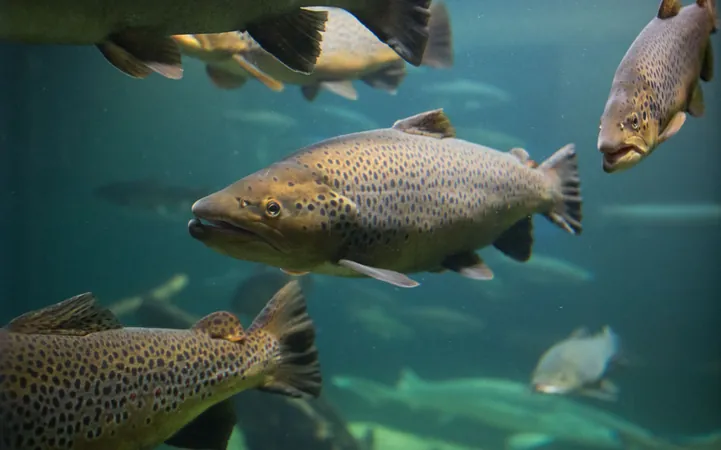
Discoveries from the Arctic: Salmon Coexisted with Dinosaurs!
2025-05-11
Author: Nur
A Surprising Discovery in the Cretaceous Period
When you picture the Cretaceous Period, towering dinosaurs usually capture the imagination. But in what is now northern Alaska, a different scene unfolded—one surprisingly familiar yet extraordinary. Freshwater streams thrived with ancient versions of fish, including early types of salmon and pike, showcasing a vibrant ecosystem.
A Groundbreaking Find: The Oldest Salmon Species Uncovered
Recent research from the University of Alaska Fairbanks has unveiled three new species of fish dating back 73 million years, among them Sivulliusalmo alaskensis—the oldest known member of the salmon family ever recorded in fossils. According to Patrick Druckenmiller, director of the University of Alaska Museum of the North, "This isn't just a new species; it redefines our understanding of salmonids in history." The name itself combines the Inupiaq term for 'to be first' with the Latin word for salmon, marking a significant discovery.
Pushing Back the Timeline of Salmon Evolution
Prior to this find, the oldest salmonid fossils were traced back to British Columbia and Washington. This new evidence extends their lineage by approximately 20 million years, offering fresh insights into their evolutionary history. Along with the salmon, fossils of two new pike species and the earliest Arctic representation of the carp and minnow group were also uncovered.
Unlikely Survivors of a Warm World
The survival of salmonids in ancient northern waters might seem peculiar, considering today’s salmon flourish in frigid climates. Yet, during the Cretaceous, when global temperatures soared, the Arctic still experienced significant seasonal fluctuations. According to fish curator Andrés López, "Salmon thrived in environments with dramatic changes—suggesting their remarkable adaptability is part of a legacy that connects them to today’s fish species in the region."
Dinosaurs and Fish: Shared Waters of the Past
The fossilized remains were excavated from the Prince Creek Formation, a renowned site rich in dinosaur bones. However, beyond the titanic reptiles, the smallest fossils can tell intricate stories about ancient ecosystems. Druckenmiller emphasizes, "Understanding the modern Arctic’s ecosystem requires insight into even its tiniest inhabitants." This principle is equally valid for ancient ecosystems.
The Quest for Skeletons: Uncovering Tiny Treasures
Locating these minuscule fish fossils was a challenge. While common in the Prince Creek Formation, their size made them easy to overlook. The team resorted to hauling back buckets of sediment for meticulous examination in the lab. Utilizing micro-computed tomography, researchers digitally reconstructed the fossils, unveiling distinct jaws that signified their salmon lineage.
A Polar Birthplace for Salmon Evolution
The findings imply that salmon might not have migrated northward as previously thought; rather, their evolutionary journey may have originated in high-latitude regions. Druckenmiller notes, "These areas likely played a crucial role in their evolution," as lower-latitude fish species were absent from the same rock layers. Thus, the story of salmon began in the shadow of Arctic dinosaurs, flowing through rivers in a dynamic polar world.
Stay Updated with Nature's Wonders!
This remarkable study sheds light on the interconnectedness of ancient life and the resilience of species through time. For more captivating discoveries like this one, subscribe to our newsletter for exclusive insights and updates!



 Brasil (PT)
Brasil (PT)
 Canada (EN)
Canada (EN)
 Chile (ES)
Chile (ES)
 Česko (CS)
Česko (CS)
 대한민국 (KO)
대한민국 (KO)
 España (ES)
España (ES)
 France (FR)
France (FR)
 Hong Kong (EN)
Hong Kong (EN)
 Italia (IT)
Italia (IT)
 日本 (JA)
日本 (JA)
 Magyarország (HU)
Magyarország (HU)
 Norge (NO)
Norge (NO)
 Polska (PL)
Polska (PL)
 Schweiz (DE)
Schweiz (DE)
 Singapore (EN)
Singapore (EN)
 Sverige (SV)
Sverige (SV)
 Suomi (FI)
Suomi (FI)
 Türkiye (TR)
Türkiye (TR)
 الإمارات العربية المتحدة (AR)
الإمارات العربية المتحدة (AR)